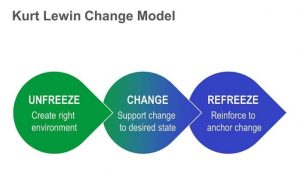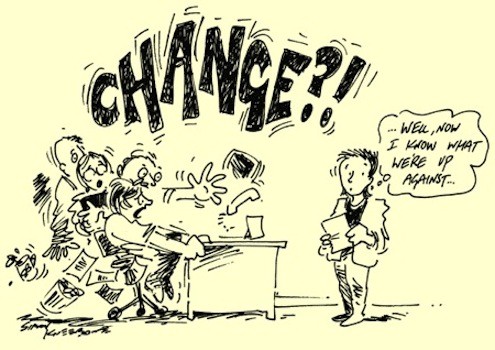Unfreeze-Change-Refreeze
Kurt Lewin was a German-American psychologist, known as one of the modern pioneers of social, organizational and applied psychology in the United States. Lewin emigrated from Germany to America during the 1930’s and is recognized as the “founder of social psychology” which highlights his interest in the human aspect of change. He is remembered even today for one of his keystone models for understanding organizational change which was developed back in the 1940s, and still holds true today. His model is known as Unfreeze – Change – Refreeze which refers to the three-stage process of change management.
When changes take place in organizations the biggest problem they face is resistance to change in terms of: is there any real need for the change? Whether needs would be met with the impending change? The risks associated with adopting the change, lack of abilities to face the change, the fear that change might fail the organization, the process of change might not be handled properly by management. Thus, organization faces a lot of inconsistency. Kurt Lewin suggested three stages for smooth changeover:
1st stage: Unfreezing
The Unfreezing stage is best handled when organizations realize that change is necessary. The biggest fact is that world around us changes each day. The business environment goes through constant change due to volatility. The first stage is about getting ready to change. It is getting ready to move away from the comfort zone. The first step is about preparation by one and all in the organization. Prior to the change, preparing people to change is most important. When majority people in the organization feel that change is necessary, it becomes urgency and people feel more motivated to have the change. This ends the procrastination; as the closer the deadline, people are more likely to snap into action and actually get the job started.
Unfreezing also means weighing up benefits and damages; if benefits outnumber the damages an action can be easily taken. This is analysis was called the Force Field Analysis by Kurt Lewin. Force Field Analysis is studying different factors for and against making change that the organization is aware of.
2nd Stage: Transition
Lewin believed that change is not an event, but rather a process. He called the process of change a transition. Transition is the inner movement or a shift we make in reaction to a change. The second stage occurs as we make the variations that are needed. In this stage people in the organization get ‘unfrozen’ and start moving towards a new way of being. This stage of shifting is often the hardest as people are unsure and fearful. The transition if not handled professionally, becomes chaotic. It creates volatility among people. The transition state often emotionally drains people, emotions ranging from anguish to nervousness to anger to anxiety to relief. During the transition, productivity predictably declines.
Transitions become peaceful when people are communicated the need for it. People learn new behaviors during this stage. The day-to-day activities are simultaneously carried on. Therefore, this stage is very challenging. Only when people are convinced themselves and they see benefit, they give signal of willingness. This is not an easy time as people are learning about the changes and need to be given time to understand and work with them. Support is really important here and can be in the form of counselling, training, coaching, advising and analyzing. The chances are they make mistakes and the mistakes must be pardoned as part of the process.
Using role models and allowing people to develop their own solutions also help to make the changes. It is very important to communicate clear picture of the desired change and the benefits to people so they do not lose sight of the destination.
3rd Stage: Refreezing
Kurt Lewin called this stage freezing which many people refer to as ‘refreezing.’ This stage is about establishing stability once the changes have been made. And when the changes are accepted they become the new norm. People form new relationships and become comfortable with their routines. This can take time. But it brings newness, freshness and innovation with it. In today’s world change takes place within days or weeks. There is just no time to settle into comfortable routines. Hence organization rarely get refreeze, the modern thinking about change is that it is continuous and sudden. Hence organizations prefer staying flexible to change. And staying unfreeze for next change is better. Given today’s pace of change this is a reasonable criticism. In 1947 Lewin wrote: “A change towards a higher level of group performance is frequently short-lived, after a “shot in the arm”, group life soon returns to the previous level. This indicates that it does not suffice to define the objective of planned change in group performance as the reaching of a different level. Permanency of the new level, or permanency for a desired period, should be included in the objective”.
British Airways case: In 1981, British Airways (BA) was considered an unproductive, loss making nationalized company. Had it been a private ownership company, it would probably have been declared bankrupt. John King, who was appointed Chairman in 1981 brought in the turnaround because the passenger airline was making annual losses of £140 million. By 1989, two years into life as a private company, BA was making over £260 million profits per year. This case throws light on change management. The first thing King did was BA was privatized. King recognized that the organizational restructuring is unavoidable, change management is compulsory.
King removed 22,000 employees while reshuffling its operations. He hired Colin Marshall as CEO. BA’s fleet of aircraft was replaced. He also removed unprofitable routes. These actions of his allows BA to shed its weight in terms of oversized staff, ineffective and obsolete fleet of aircrafts, thus, helping the airline to reshape itself. Though the need for change and the type of change required was obvious to the new chairman, King realized that the organizational restructuring would affect every single person associated with the company.
King knew that the change should occur in a systematic timeframe, it cannot linger on for years and the reason and implications change must be communicated to the employees, without wasting too much of time he communicated the cause of restructuring by putting a plan in place to achieve the goals of organizational change. In the case of BA, the ultimate goal was the privatization of the company. To get there, King first had to ensure its survival. To achieve the goals King involved the whole organization in his change management plan: from HR, operational staff, technology, engineering, aircrews, and administration. He realized that resolving conflicts and dealing with resistance to change was part of the change management process.
Lewin’s Unfreeze-change-refreeze can be explained in the following steps adopted by BA:
Unfreeze:
King created a sense of urgency: The urgency was simply communicated; the employees were told either change or face closedown of the airline. The staff was told that it would be rather prudent to close the airline, rather than continue making losses of huge sums every year.
The new vision and mission was communicated to all stakeholders. The stakeholders were made aware to act upon the action plan. When stakeholders are involved in the change process, the change can be effectively carried on more swiftly. If restructuring involves job losses, then stakeholders should involve workers’ groups or unions.
Change:
A flexible atmosphere for created for the change: It is very important to realize that rigidity does not allow to change, people and processes are interlinked, hence resistance should be avoided at each stage.
Change management must be led by leaders: Change management must be led by the leaders consistently and supported by managers at all levels. These managers not only convey the message down the line, but also report on feedback and progress.
Implementation plan must have clarity: Strategizing change requires following the project implementation plan. The two will go hand-in-hand, as all stakeholders move toward organizational strategic goals.
Refreeze:
Cultivate behavioral change: after changes are brought in, the change must be projected through people and their attitude. People should walk the talk of the adopted change. At this stage counsellors and mentoring helps people a lot. In 1982, Colin Marshall became the Chief Executive Officer (CEO) of British Airways plc. In this period, British Airways produced its first additional profit which was the outcome of the cost-cutting actions implemented by John King. Colin Marshall decided to pay attention to its customer service in order to ensure that company carries on making profit. Marshall hired Consultants to collect data about workers and customer attitudes. Significant gaps were plugged between what was delivered by BA staff what the consumer actually required.
















































